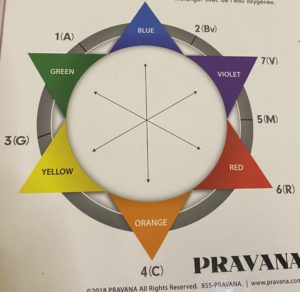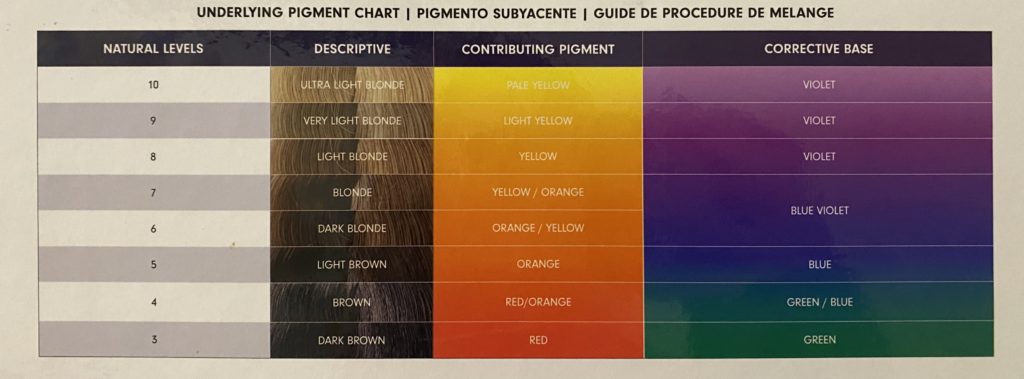
The Color Wheel & Why It’s Important For Hair
The color wheel isn’t just for art class! I use the color wheel every single day in my hair salon. It’s what makes and breaks a corrective color service.
In this post I reference the level system in hair color. If you aren’t familiar with the level system then check out my post here.
Below you can see my Youtube video on using the color wheel to fix or correct your hair color.
Color wheel colors
The color wheel is a spectrum of all primary, secondary, and tertiary colors.
Primary colors
These are the three main colors that cannot be created any other way. All colors are made by a mixture of these three colors.
Blue
Red
Yellow
Secondary colors
These colors are made by mixing together equal parts of two primary colors.
Green is made by mixing yellow and blue
Orange is made by mixing red and yellow
Violet is made by mixing red and blue
Tertiary colors
These are mixtures of a primary and a secondary color:
Green/blue (teals or turquoise)
Blue/violet (indigo)
Violet/red (mahogany or maroon)
Red/orange (deep copper)
Orange/yellow (mustard)
Yellow/green (lime)
What are the numbers in hair color
A lot of hair color lines use letters to describe the tone of the hair color, but most have translated these letters to numbers so they are universal for different languages.
The letters translate to numbers as follows:
Sheer (no tone) – 0
Ash (green base) – 1
Beige (blue/violet base) – 2
Gold (yellow base) – 3
Copper (orange base) – 4
Mahogany (violet/red base) – 5
Red – 6
Violet – 7
Pearl (pink/silver base) – 8
Silver – 9 (blue base)
In hair color, these numbers will come after the period. The number before the period is the level, or lightness/darkness of a hair color. To learn more about the level system, check out my pervious post here.
In the photo below, the first color 4.52 translates to level 4, mahogany beige brown.

What does the color wheel have to do with hair color?

As hair stylists we use the color wheel to enhance or neutralize colors or tones in the hair. This is key in formulating the hair color to reach the desired outcome. Read below to learn about neutralizing (or correcting) unwanted hair color tones by utilizing the color wheel.
What does neutralizing hair color mean?
When a brunette says that they feel their hair color has too much “red” or warmth in it, we neutralize the red by adding a color with a green base. This is because green is the opposite of red on the color wheel. This will cancel out the red to produce a more neutral tone.
When a blonde says that they want an ashier tone and not so yellow, we neutralize the yellow with a toner that has a violet base. This is because violet is the opposite of yellow on the color wheel. This is why purple shampoo is made for blondes only, because violet neutralizes the yellow in blonde hair.
The amount of neutralizing pigment that you add to the hair color is dependent on what your desired outcome is, as well as what the current tone is. You may only need a slight amount of the neutralizing pigment, or you may need a lot of it.
The neutralizing pigment is mixed in with the desired color. Let’s say your looking for a neutral brown, but there is too much red in the current color. We would mix a color with an Ash/green base (5A) in with a neutral color (5n).
Typically I add in 25%, 50%, or 75% of the correcting pigment, depending on how much of the tone I am looking to neutralize. If there is only a slight red hue, then I don’t need to add much and can get by with 25% Ash. But if the color is bright red, I would add 75% Ash to the Neutral tone.
The color wheel and toning hair
Utilizing the color wheel is basically the definition of toning hair. In order to get the tone you want, you use the color wheel to tell you what to put on it.
I am always shocked when blonde clients come in and tell me that their previous stylist did not use a toner on them.
When lightening ANY hair, it pulls warm. This is because the underlining pigment of the hair is exposed when moving up the levels of lightness/darkness. Depending on the level, your hair will turn red (level 3 and under), red/orange (level 4), orange (level 5), orange yellow (level 6), yellow orange (level 7) yellow, (level 8), light yellow (level 9), or pale yellow (level 10).
Most of the time this tone is not desired. And even if they do want it, its best to tone it accordingly.
Toning will neutralize and remove any unwanted tones, while enhancing wanted tones. So if your hair is yellow and you want that removed, you need to tone the hair with a violet base.
This will brighten the blonde without having to lighten it further with bleach and give you a gorgeous tone.

What does purple shampoo do?
***Since I’m sharing the products that I love to use with you guys, this page includes affiliate links to these products. If you take action and purchase a product through clicking one of my links, I’ll make some commission money from it at no extra cost to you. This enables me to be able to continue giving you awesome hair tips, so thanks! ***
Toning shampoos are a great addition to keeping your hair on tone as your hair color (or toner) fades.
Today, these shampoos come in any color desired. The most common are purple shampoos for blondes, but you can use one as a brunette also! You can find my favorite toning shampoos and conditioners below.
- Olaplex 4P Purple Shampoo
- Olalex 5P Purple Conditioner
- Gem Lites Brown Tahitian Pearl Shampoo & Conditioner (removes unwanted red from brunettes)
Color harmony with complementary colors
The color wheel is also used to produce color harmony. This can be with highlights and lowlights, or even bringing out eye color.
Complementary colors are typically colors that are opposite of each other on the color wheel. The same two colors that you use to neutralize, will also compliment eachother.
So if you have green eyes, adding red to your hair will really make them pop. This can be all over red, or even just red highlights or peekaboos.
And if you aren’t a huge fan of red, you can veer off a little and use a red violet (mahogany), violet, red orange, or orange (copper). Any of these choices have red in them and will make the eyes pop.
I like to use complimentary colors when deciding on a tone for a highlight or lowlight. If you have a violet brown base, I may add a golden tone as your highlight. This can be a caramel, golden brown, or golden blonde.
This is also helpful with choosing your eye shadow color when applying your makeup. If you have blue eyes, warmer colors will make your eyes POP. I like to wear pink and purple eye shadow shades because my eyes are light blue.
Why box dye doesn’t work
It is extremely important to use the color wheel when formulating your hair color because you can end up with something completely different than your desired goal. The color wheel helps hairstylists formulate hair color to make it a specific tone or shade, as well as cancel out any or all unwanted tones.
This is why box color does not work. You can’t pick a color out of a book and apply that tube on any and every canvas and expect it to come out the same. There is not a one size fits all hair color.
I hardly ever take one color tube out of the box and use it on a client. 95% of the time, I am mixing multiple tubes together in different ratios to formulate a tone specifically for their desired hair shade based on what their hair currently looks like.
The Color Wheel Conclusion
As you can see there is a lot more to hair color than you probably expected. Not only are we chemists, but we are also artists that utilize the color wheel to craft the perfect color combination to keep your hair looking gorgeous.
- Primary colors – Blue, Red, Yellow
- Secondary colors – Green, Orange, Violet
- Tertiary colors – Green/blue, Blue/Violet, Violet/Red, Red/Orange, Orange/Yellow, Yellow/Green
- In hair color, shades are referred to as numbers: 0 is sheer, 1 is ash (green/blue), 2 is beige (blue/violet), 3 is gold, 4 is copper, 5 is mahogany (violet/red), 6 is red, 7 is violet, 8 is pearl (pink/silver), and 9 is silver (blue)
- Use the color opposite on the color wheel to neutralize the undesired tone
- Add in 25%, 50%, or 75% of the neutralizing tone to the desired color based on how much of the undesired tone is present
- Use the color opposite on the color wheel to create complimenting tones
- All hair color must be formulated with the color wheel based on the starting canvas to reach the desired outcome. This is why box color doesn’t usually work
I hope this helps explain a little bit about how hair color works so you can understand what we are doing to your hair and why!
Leave me any further questions you have for me in the comments. And be sure to subscribe below if you want to make everyday a good hair day!
Last updated 02/27/2024



Comments